Poor Oscar Moore, Fell & Hit The Floor (1884)
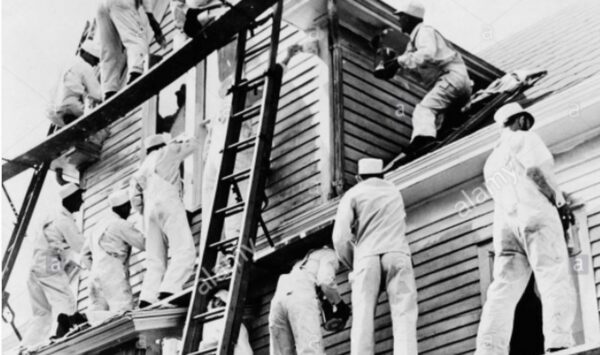
******************************************************************************************************************************** Brownstone Detectives investigates the history of our clients’ homes. The story you are about to read was composed from research conducted in the course of one of those investigations. Do you know the history of YOUR house? ******************************************************************************************************************************** We Brooklynites can sense history all around us. It does not jump out at us like ghosts or drift in our direction like disembodied voices from walls. But we know it is there. Sometimes it takes a little physical research to understand what it is that happened at a particular location, though – just to see it. Take the case of the brownstone at No. 272 South 5th Street in Williamsburg, for example – literally, at the base of the Williamsburg Bridge. The facade shows what appears to be an unassuming 3-story and basement 19th century tenement. But something once happened there – literally, right there out in front of the house – that changed a man’s life. POOR OSCAR MOORE A short piece in the Brooklyn Daily Eagle of 11 January 1884, noted that a painter, by the name of Oscar Moore, who lived at 143 Marcy Avenue, had been working on a scaffold at the Fifth Street location, painting the front of “No. 272 South Fifth Street.” Then he fell. According to the paper, Moore “sustained a severe fracture of the right side.” It is likely that a surgeon was dispatched to tend to Moore. He probably did little more than assess Moore’s status and then, with the help […]
SUNSETTING ON A BED-STUY BOULEVARD (1909)
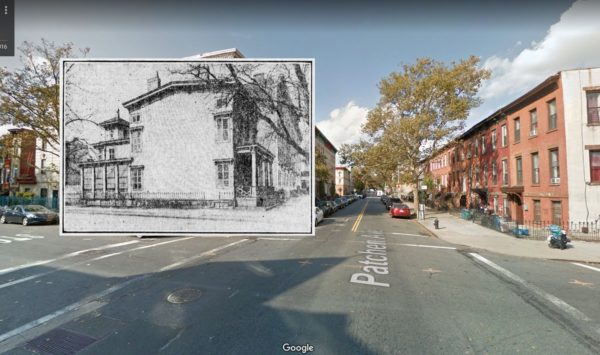
******************************************************************************************************************************** Brownstone Detectives investigates the history of our clients’ homes. The story you are about to read was composed from research conducted in the course of one of those investigations. Do you know the history of YOUR house? ********************************************************************************************************************************In 1909, a landmark was about to be destroyed. It was quite common, though, at the time for owners to tear down the antiquated wood-frame mansions that dotted Brooklyn’s landscape. Since the new brownstone houses had become all the rage in the 1880s, these tinder “firetraps” had become redundant, difficult to sell, and simply unstylish to live in. By the late 19th century, they were being sold, in many cases, for the value of their land as building lots. And with the demise of these historical artifacts, went some truly beautiful examples of mid-19th century architecture, few of which remain with us to this day. THE DE MILLE HOUSE The De Mille house was built around the middle of the 19th century for the family of that name, “and it has been a landmark in that region since the days when it was surrounded by open fields.” Yes, even Bedford-Stuyvesant – today chockablock with brownstone and masonry homes – was once – even before the advent of wood-frame homes – forested land alongside open virgin fields. As a matter of fact, the corner of Quincy and Patchen, in the 1850s, was little more than hills, dales, dirt lanes, and the vague promise of a future suburban city. “Broadway, which is nearby, was […]
FIRE, FUN & FIASCOES ON THE 4th (1887)
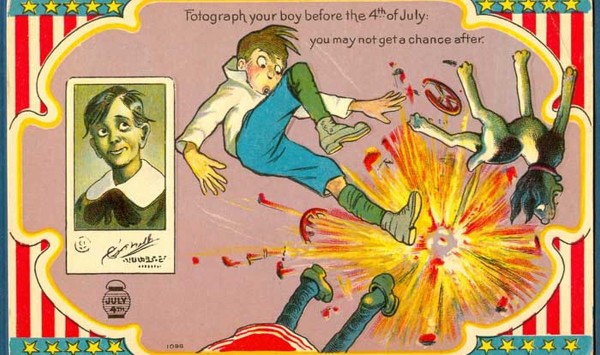
******************************************************************************************************************************** Brownstone Detectives investigates the history of our clients’ homes. The story you are about to read was composed from research conducted in the course of one of those investigations. Do you know the history of YOUR house? ******************************************************************************************************************************** A lot of accidents happen on the 4th of July. While it has been a day of celebration for Americans since its inception, certain citizens have tended to go a bit too far with their fireworks and other dangerous weapons. Back in 1887, a few days after Independence Day, a listing of the damages occurring and casualties effected on that date appeared in the Brooklyn Daily Eagle – once the authorities had had the time to assess the collective destruction. “Pistols and pyrotechnics of every kind were used with absolute impunity by even mere children,” the paper noted, “and the wonder is that more accidents did no occur.” The following list reflects a number of police blotters and lays out the accidents occurring primarily in the Eastern District (Williamsburg and Bushwick areas, and parts of Bed-Stuy). It is partial, but it will 1) boggle your mind, and 2) make you laugh. FIRE CRACKERS AS ASSAULT WEAPONS 8:30 – A boy whose identity could not be discovered threw a firecracker at the peanut stand outside the frame building at 21 Grand street and set it on fire. The building, which was owned and occupied by Sauer Brothers as a saloon, was damaged to the amount of $500 before the flames were extinguished. […]
THE CAT MAN OF GWINNET STREET (1896)
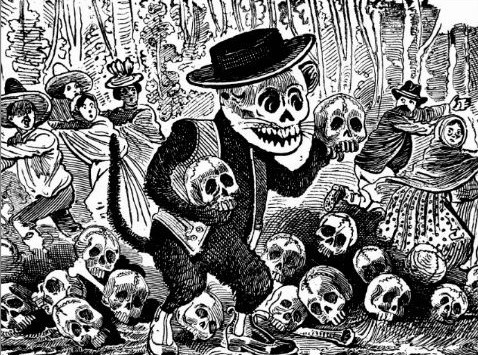
******************************************************************************************************************************** Brownstone Detectives investigates the history of our clients’ homes. The story you are about to read was composed from research conducted in the course of one of those investigations. Do you know the history of YOUR house? ******************************************************************************************************************************** Haasen-pfeffer is a German dish best served hot. A traditional German rabbit stew, it was brought over to the US by immigrants. (Hase is German for “hare,” and pfeffer is German for “black pepper.”) Although rabbits are the chief ingredient in the old-world dish, German immigrants in the early days of the country would often substitute squirrels. But never cats. Until Herman Fritsch appeared on the scene in Williamsburg in 1896. THE CAT MAN OF GWINNET STREET The locals were first alerted to the possible rabbit substitute in their stews when several neighbors heard a terrible racket occurring one night at Fritsch’s home, 168 Gwinnett Street (now Lorimer Street). As the neighbors listened, they began to hear a horrible howling coming from his rooms above a liquor store. They thought the cries sounded like “the screams of a child or woman in distress.” A consultation amongst several of the neighbors quickly took place, after which they decided that “murder was surely being committed in Fritsch’s apartments.” So Officer Lang of the Clymer Street Station was called for. While the neighbors waited, though, there was a last despairing shriek. And then all was still. OFFICER LANG ON THE JOB By the time Officer Lang arrived, “not a sound was heard” within the […]
LEARNING TO BOOGIE IN WILLIAMSBURG (1857)
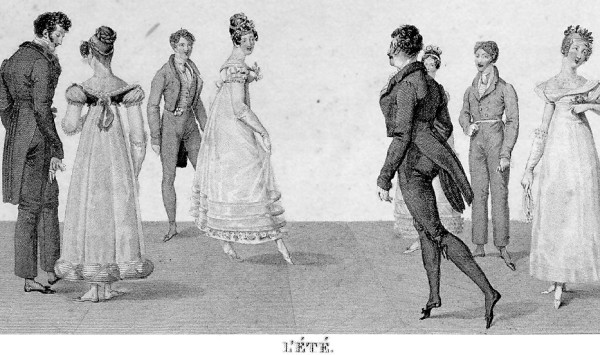
******************************************************************************************************************************** Brownstone Detectives investigates the history of our clients’ homes. The story you are about to read was composed from research conducted in the course of one of those investigations. Do you know the history of YOUR house? ******************************************************************************************************************************** People loved to dance back in the 1800s. Their dancing was mostly formal, almost mimicking a prepared act, but it took place in social settings allowing participants to display a good amount of that godly grace their lives often lacked. And people danced not just to exercise, but to socialize, to entertain themselves, and to hear about the latest news from their old and new friends. And everyone wanted to know the latest dances so that they were not embarrassed in such polite company, or so that they could – at the very least – discuss these dances intelligibly. THE 19TH CENTURY’S DISCO In 1857, the Lancers’ Quadrille was all the rage – and by “all the rage,” I mean “ALL THE RAGE.” It seemed that every dance school was teaching it, every tongue was wagging about it, and every newspaper dance academy ad offered its instruction. The Lancers’ Quadrille was a dance performed by four couples – it was a precursor of sorts to the square-dance, albeit a more refined square dance where everyone dressed supper classy and pretended to be nobility. SQUARE DANCIN’ IN BILLYBURG (W/PROF. TRENOR) In Williamsburgh, there existed Professor Trenor’s Private Dancing Academy, at No. 90 South Eighth Street near the East River. It was likely […]
A “9-YEAR-OLD HABITUAL DRUNKARD” (1900)
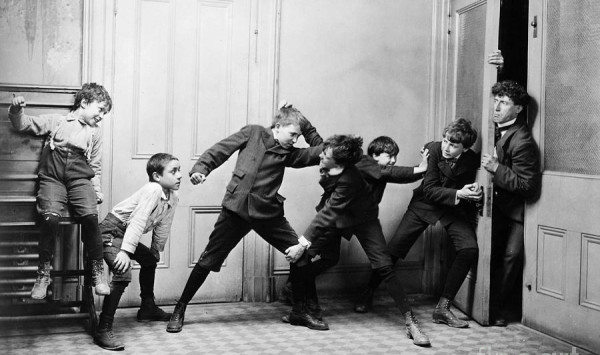
******************************************************************************************************************************** Brownstone Detectives investigates the history of our clients’ homes. The story you are about to read was composed from research conducted in the course of one of those investigations. Do you know the history of YOUR house? ******************************************************************************************************************************** A few years ago today, the internet was abuzz with the story of a 9-year-old boy who drank, smoke pot, and was abusive to everyone. Maybe scandalous in today’s world, but back in the 19th century it was apparently a more common occurrence. In a world where 9-year-olds were habitually asked to run down to the corner bar and get their father’s (or mother’s) beer pail or growler filled, such boys were plentiful. BOARDING BOYS Children were also less protected, as we all know, back in the day. They were frequently even boarded with other families in the neighborhood, or shipped off to those who advertised their services in the newspapers. These latter were usually those who were house- or room-rich (had enough extra room for children wherever they lived), but didn’t necessarily have the income needed for getting by. Boarding children was just another way of making ends meet. “BOARD – TWO OR THREE CHILDREN wanted to board; will be instructed. Apply at 98 Troutman st.,” read one ad, for instance, appearing in the Daily Brooklyn Eagle in 1885. But it was not always those seeking boarders who had the bad children who drank, smoke, and cursed. At the very same address listed in the ad above, 98 Troutman Street, […]
THE GHOST OF 281 STUYVESANT AVENUE (1901)
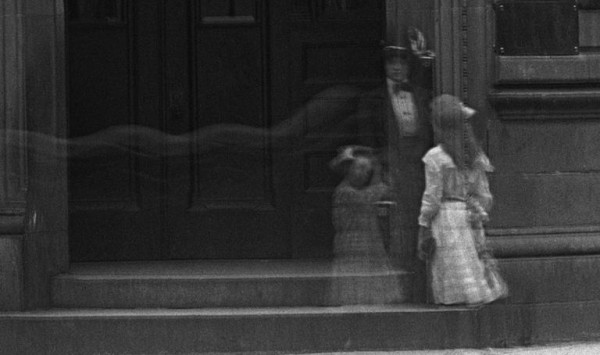
******************************************************************************************************************************** Brownstone Detectives investigates the history of our clients’ homes. The story you are about to read was composed from research conducted in the course of one of those investigations. Do you know the history of YOUR house? ******************************************************************************************************************************** “At last Stuyvesant Heights revels in the proud possession of a genuine haunted house.” This was back in 1901, when Stuy Heights was relatively young, the houses newish, and the ghosts scarce. But Stuyvesant Heights had everything back then – “a Republican Club, an amateur dramatic society,” and even “several asphalt streets where bashful maidens learn to wheel at night.” So why not a ghost? THE HAUNTING AT NO. 281 STUYVESANT AVENUE The Griffins, who had lived in the apartment house at the ground floor were terrorized by their electric bell ringing at 2 o’clock every afternoon. But they also heard “hollow groans,” “creepy sidesteps on the staircase,” and “unexpected trips from room to room of pieces of furniture.” It all got to be too much for the Griffins to handle, and so they fled. The Griffins moved to Williamsburgh. PERFECTLY GOOD EXPLANATIONS Some of the other tenants blamed the wind. A young woman who lived in the second floor apartment told an Eagle reporter that everything was perfectly explainable. “This house, you know, stands alone and the wind, when it sweeps into the vestibule, often comes hard enough to blow the whistle in the kitchen tube,” she explained. “Then it’s a fact that the pictures do move, but that’s caused […]
THE FLIGHT OF MOSES MAY’S MAD COW (1865)
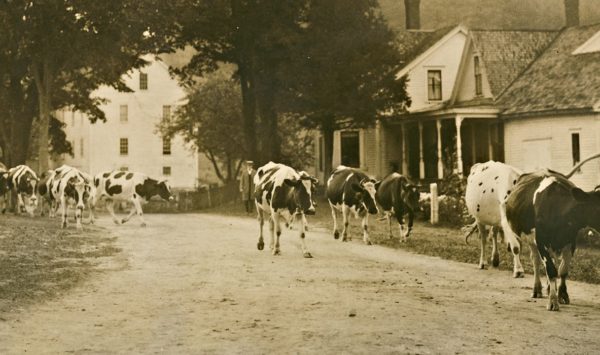
******************************************************************************************************************************** Brownstone Detectives investigates the history of our clients’ homes. The story you are about to read was composed from research conducted in the course of one of those investigations. Do you know the history of YOUR house? ******************************************************************************************************************************** Enjoy this old story about some Brooklyn cows getting loose outside of their normal environs – which, back in old Brooklyn, were quite often our city streets. While doing house research, we found a colorful little story in the Brooklyn Daily Eagle of 1865. It involves two Germans and an Irishman, as well as a supporting cast of a number of primarily immigrant Brooklynites. The story is led by a main character – a pretty “mad cow” – the kind with horns – that went rushing down Bushwick Avenue, having to be taken down by a “citizen,” whereupon it was delivered to a local slaughterhouse for gutting and the production of many sides of meat. Although the article does not expressly state such – stories from this period were famously short on important details – it appears that the original owner lost his cow to a number of very hungry Bushwick pre-hipster citizens. THE FLIGHT OF MAD BESSIE DOWN A VERY BUSY BUSHWICK To set the scene, it all started at about 4 p.m. on Bushwick Avenue in the 16th Ward. Mr. Moses May, a German immigrant of 136 Remsen Street, was driving a drove of cattle along the avenue, after a long day of their bovine grazing in a field, […]
A CHILD SNATCHING ON CLASSON (1875)
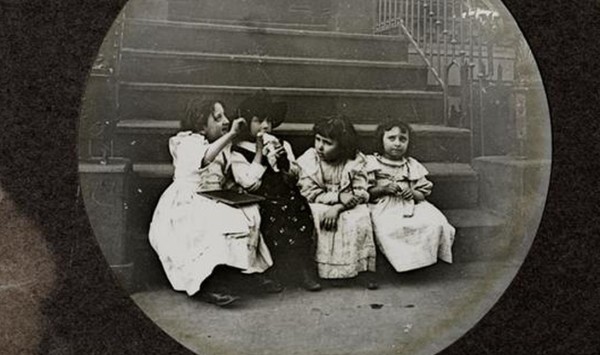
******************************************************************************************************************************** Brownstone Detectives investigates the history of our clients’ homes. The story you are about to read was composed from research conducted in the course of one of those investigations. Do you know the history of YOUR house? ******************************************************************************************************************************** He was “large.” He was “repulsive looking.” And he wanted to steal a child. And so, when Michael Kelly, of No. 22 Franklin Avenue, heard the joyous amusements of a number of young children upon a stoop at No. 208 Classon Avenue, he was resigned that he should have one. Ascending to where they were, he seized little Josephine Carter, aged 3 years, and “despite her cries of alarm, began a hasty retreat.” As he reached the bottom step and turned to flee down the walkway, little Josephine’s head knocked violently against the iron railing, causing her to cry all the more loudly. The children who remained on the stoop, “their playmate having been removed so from their midst, were all terrified, and began to cry in concert.” This crying attracted the attention of a Mrs. Hartley, who resided next door at No. 206 Classon. She, “supposing there had been an accident of some sort, hastened to the street just in time to see Kelly running off with the little girl.” THE CHASE “Very pluckily she followed him for nearly half a block and finally overtook him. Demanding the instant release of the child, she wanted to know why he was carrying it away.” Kelly, though, pretended to be deaf and […]
REDEMPTION COMES FOR A BOY FIREBUG (1913)
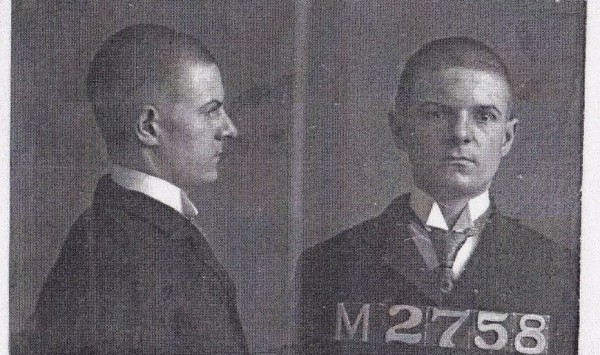
******************************************************************************************************************************** Brownstone Detectives investigates the history of our clients’ homes. The story you are about to read was composed from research conducted in the course of one of those investigations. Do you know the history of YOUR house? ******************************************************************************************************************************** (Ed.’s Note: A few weeks ago we received a letter from out of the blue. The writer claimed something fantastic – something astounding. It was a coincidence that spawned a story which gave life to an incredible – but true – tale. A story that we had written in a Brownstone Detectives blog several months earlier had recently popped up in this gentleman’s Google search about his great-grandfather. His great-grandfather, though, was no ordinary Brooklynite. For months in 1899 he had set fires in the houses – and fear in the hearts – of the Brooklynites of the Eastern District. He had also set the city to talk about, theorize on, and fabricate what had been causing the fires and where they would blaze next. The story you will read lays out the very particulars and the characters involved in the case. It is written by a particularly credible and relevant source of the information, information that was uncovered through some keen and dedicated detective work. For the gumshoe detective work behind this piece of crime investigation was performed by a man who only last year came to learn of this fantastic and amazing tale – fantastic because it was about his family, and amazing because no one in his family […]